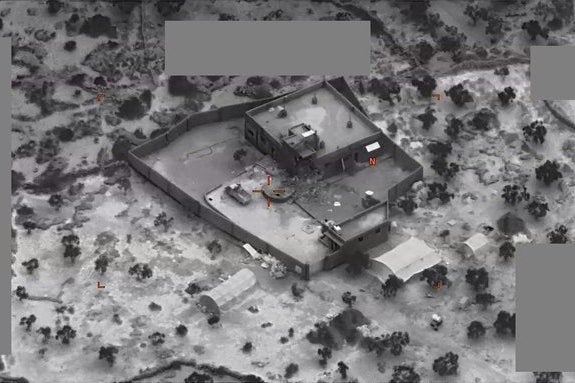
The Pentagon released more details about last weekend’s nighttime raid that killed ISIS leader Abu Bakr al-Baghdadi in northwest Syria’s Idlib province. Briefing reporters Wednesday, Gen. Kenneth McKenzie, the top commander of U.S. Central Command, presented grainy, black-and-white aerial footage of the operation as Special Operations troops approached the Baghdadi’s compound just four miles from the Turkish border. McKenzie the timing of the raid was based on “fleeting and actionable” intelligence and that he gave the order to initiate the operation from Centcom’s Tampa headquarters around 9 a.m. local time on Saturday. The mission involved nearly 100 American troops being transported by eight Chinook helicopters from a staging base inside Syria.
The video shows the aircraft taking small arms fire as they approach the compound. U.S. forces engaged, killing between 10 and 15 enemy fighters, although they were not necessarily affiliated with Baghdadi or aware of his presence. Five adults—four women and one man—were killed at the compound in addition to Baghdadi after they did not respond to verbal commands to cooperate. Several of the killed were wearing suicide vests, according to the Pentagon. Two children—not three as initially reported by U.S. officials—were killed when Baghdadi detonated an explosive vest as he was about to be captured. Two more suspected militants were apprehended and transported from the compound.
McKenzie described Baghdadi’s existence as isolated in the extreme, making it unlikely he had access to the internet or digital communications. Nearby ISIS fighters were likely unaware of his presence. “I think you’d find (he was using) probably a messenger system that allows you to put something on a floppy or on a bit of electronics and have someone physically move it somewhere,” McKenzie said. U.S. forces were on the ground at the compound for more than two hours before aerial strikes were carried out by fighter jets and drones. The video shows a plume of smoke following the bomb strikes destroying the compound. McKenzie said destroying the compound was, in part, “to ensure that it would not be a shrine or otherwise memorable in any way.
“We suspect they will try some form of retribution attack,” McKenzie warned. “And we are postured and prepared for that.”
from Slate Magazine https://ift.tt/334LyvU
via IFTTT
沒有留言:
張貼留言